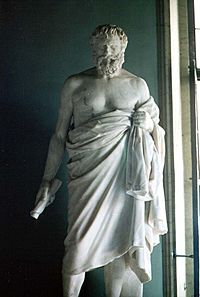Cynic facts for kids

The Cynics were a group of philosophers in ancient times. Their ideas formed a special way of thinking called Cynicism. They believed that the main goal in life was to live a good life, following what felt natural.
This meant saying no to many common wishes. Things like wanting lots of wealth, power, perfect health, or being very famous. Instead, they thought people should live without owning many things. They believed humans are thinking creatures. So, they could find happiness by training their minds and living in a simple, natural way.
Cynics also thought that the world belonged to everyone equally. They felt that sadness and problems came from wrong ideas about what is truly important. They also thought that many customs and rules in society were not useful. Some of their ideas were later used by another group of philosophers called the Stoics.
What Did Cynics Believe?
Cynics had strong beliefs about how to live a good life.
Living in Agreement with Nature
- Cynics believed people should live simply.
- They thought we should follow our natural instincts.
- This meant ignoring many rules of society.
- They felt that nature showed the best way to live.
Rejecting Material Things
- Cynics did not want money or fancy homes.
- They thought these things made people unhappy.
- They chose to live without many possessions.
- This helped them feel free and independent.
Finding Happiness Through Virtue
- Cynics believed that true happiness came from Virtue.
- Virtue means being good and doing the right thing.
- They thought this was more important than wealth.
- They trained themselves to be strong in mind and spirit.
Famous Cynic Philosophers
Cynicism was started by a few key thinkers.
Antisthenes: The First Cynic
- The first philosopher to teach these ideas was Antisthenes.
- He was a student of the famous philosopher Socrates.
- Antisthenes lived in the late 5th century BCE.
- He started the main ideas that Cynics would follow.
Diogenes of Sinope: The Archetypal Cynic
- After Antisthenes came Diogenes of Sinope.
- Diogenes took Cynic ideas to an extreme level.
- He famously lived in a large tub on the streets of Athens.
- He became known as the perfect example of a Cynic.
Crates of Thebes: Giving It All Away
- Another important Cynic was Crates of Thebes.
- He was very rich but gave away all his money.
- Crates chose to live a life of Cynic poverty in Athens.
- He showed that wealth was not needed for happiness.
The Spread and End of Cynicism
Cynicism grew and changed over time.
Cynicism in the Roman Empire
- Cynicism became more popular when the Roman Empire grew.
- This happened around the 1st century.
- Cynic philosophers could be found everywhere.
- They would beg and share their ideas in many cities.
The End of an Era
- Cynicism slowly faded away by the late 5th century.
- However, some of its ideas lived on.
- Things like living simply and speaking strongly.
- These ideas were later used by early Christians.

